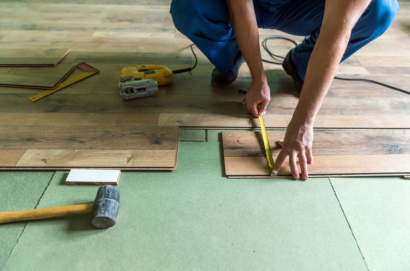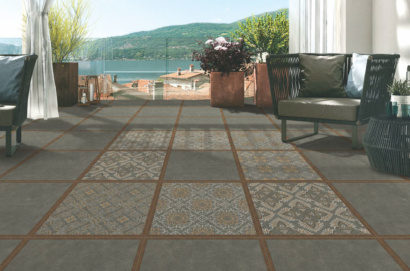The choice of flooring materials can be critical is you have several pets, a single pet that’s especially rambunctious—or if you run a commercial business specializing in pet health or pet care, such as a veterinarian clinic or animal boarding facility. Different types of animals can have various damaging effects on floors, through shedding, toenails, nails, and urine or excrement. You need to choose a surface floor covering that is durable, stain-resistant, and relatively easy to both sanitize and clean.
Here are six good options for flooring in spaces that see a lot of use by active pets.
Glazed Ceramic Tile
- Glazed ceramic tile is the go-to choice when you need durable, stain-resistant, easy-to-clean flooring. The inherent strength of the materials means that they won’t break, crack, or chip, even when handling the largest pets. At the same time, the glazing makes the surface impermeable to penetration by water and staining materials. Urine or excrement accidents can be cleaned up in moments with soap and water. Because liquids do not penetrate, ceramic tile is a very hygienic surface that is easy to disinfect.
- Grout joints, which are filled with porous cementitious material, can be susceptible to staining unless they are sealed. It is important to reseal the grout joints every year or two to keep the surface impervious to liquids.
- If there are any drawbacks to ceramic tile for animal spaces, it is that the surface can be slippery and cold. Where feasible, underfloor radiant heating systems can make ceramic tile delightful for animals. And choosing a matte finish rather than a high-gloss finish for the tile can make it less slippery to animal paws.
Vinyl Flooring
- Vinyl is a type of resilient flooring that is sold in fragile sheets or tiles—or click-lock planks, known as luxury vinyl. A human-made manufactured material, vinyl is resistant to stains and water penetration, and it can be wiped free of debris quite easily. It can also be sanitized using any standard commercial cleaning agent, allowing you to kill any germs or lingering microorganisms that may arise from unwanted pet behaviors.
- Vinyl tile is generally applied with adhesives that bond it to the wood underlayment; sheet vinyl is used either by troweled adhesives or by a perimeter bond method that adheres only to the edges and seams, while the inside areas “float” on the floor. This perimeter bond method can sometimes be problematic is spaces where dogs run and play because there is the possibility of toenails catching and gouging the loose vinyl. Full-bond vinyl flooring rarely has this problem.
- Because sheet vinyl or vinyl tile is quite thin, it takes on the characteristics of the subfloor that it is installed over. If it is laid on a hard surface such as concrete, it becomes like a second skin, hugging so close that animal claws will have trouble puncturing or tearing its outer layer. And vinyl is a much less expensive choice than ceramic tile, though it doesn’t last as long.
- A more up-scale form of vinyl is luxury vinyl flooring (LVF), which is usually installed in semi-rigid planks that assemble with click-lock joints. Luxury vinyl creates a notably more attractive appearance, and while the cracks between planks can be a problem if pet urine seeps through them, some manufacturers offer products with pet-friendly surfaces that are impervious to pet stains and which provide tough resistance to scratching.
Linoleum
- The draw of linoleum in a commercial location for pets is that it is a durable and stain-resistant resilient material that is also all-natural and ecologically friendly. When manufactured with a wear layer that repels the vast majority of harmful substances, linoleum is easy to clean, easy to care for, and can handle the rigors of dealing with cats, dogs, and other pets.
- Unlike other resilient options, linoleum is made from readily renewable linseed oil and other natural materials. This flooring is lightweight, low impact, and doesn’t have any of the problems with off-gassing of volatile organic compounds (VOCs) that vinyl sometimes faces. It is a great choice where you want to use an environmentally responsible “green” flooring material that has the same virtues as vinyl.
Concrete Flooring
- Concrete is generally an inexpensive flooring choice if you are in a first-story or basement location where concrete is already present as a foundation slab; however, it will need to be treated to make it suitable for a space that is frequently trafficked by animals. This requires the regular application of an appropriate concrete sealer to cover the porous surface. This protects the material from liquid penetration and stains, and it creates a solid clear surface that you can then scour clean as necessary.
- If you fear that a concrete floor means a dreary, industrial look, think again. There are many different coloring, etching, and polishing techniques that can make a concrete floor serve as a full-fledged design element for your space.
- Concrete floors are most practical in spaces that already have concrete slab foundations. Where the floor framing uses wood platform construction, a concrete floor is still possible, but it may require expensive structural reinforcement and special installation techniques.
Rubber Flooring
- Rubber flooring is often found in locations that have environmental challenges but where a comfortable, relaxed, and safe environment is needed, such as gyms or playrooms—or spaces heavily used by pets.
- Rubber flooring is resistant to almost all staining and liquid penetration hazards and is extremely durable against rips tears and gouges. At the same time, it is soft, plush, comfortable, and quiet, which can be an important feature when trying to create soothing interior spaces for animals. Rubber flooring has a further benefit of being a non-slip surface.
- But there are several potential drawbacks to rubber flooring for spaces used by animals:
- While generally resistant to stains, prolonged exposure to acidic substances such as urine can cause discoloration.
- Rubber flooring can be expensive, which may make it a prohibitive choice for large expanses.
- Rubber flooring can have a strong smell that is unpleasant to some animals, although the odor typically fades with time.
Artificial Grass
- While artificial turf might not be the flooring you want throughout a home or office space, it can be ideal for spaces where pets are confined, such as individual kennels or rooms where a pet spend long periods of time. Modern artificial grass is considerably more attractive and comfortable than the original astroturf, and dogs generally enjoy the feel of it when playing or lying on it.
- When used for indoor animal spaces, make sure to choose a product with a solid urethane backing that is impervious to moisture and which can be washed with soap and water. Some animals don’t realize the difference between real grass and artificial turf, so it’s to be expected that they may have accidents in rooms covered with artificial grass.
- Artificial grass can be laid over existing subfloors or even existing vinyl or hard flooring, much as the carpeting is installed.
Flooring to Avoid
- There are some common flooring materials that should be avoided in spaces used heavily by pets. In general, it’s best to avoid flooring materials that are hard to clean, that is easily scratched or damaged, or that are susceptible to moisture penetration.
- Carpet is arguably the worst of all flooring materials when it comes to pets because the inevitable accidents from urine or solid waste can seep in and be nearly impossible to fully eradicate. Cats may come to view carpets as very large scratching pads.
- Wood is not only expensive as a flooring material but very prone to scratches from the toenails of dogs. Urine stains can badly discolor hardwood.
- Laminate flooring is sometimes touted as a good pet flooring by manufacturers—and it is indeed preferable to hardwood, which many laminates try to emulate. But be aware that laminate flooring is slippery, loud when toenails click across it, and it’s susceptible to scratches. The cracks between planks can allow urine to seep through and damage the core layers of the flooring and underlayment. While laminates can be damp-mopped, they do not react well to heavy mopping or puddles. One advantage to laminate flooring is that it is relatively inexpensive, but expect to replace it every five to 10 years in spaces heavily trafficked by pets.
Source: https://www.thespruce.com/pet-friendly-commercial-flooring-1314682






